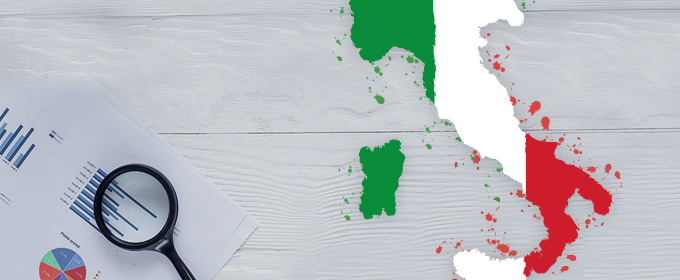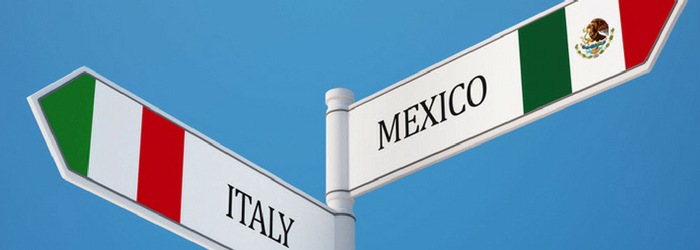
The Italian Republic is in the center of the Mediterranean Sea, in southern Europe, which makes it a strategic country for international trade. Based on data from Expansion (2021), Italy is one of the 10 most important economies in the world, reaching a Gross Domestic Product (GDP) of 1.6 trillion euros in 2020. In addition, it has an area of 301,340 km2 and a population of 59.6 million people.
In 2020, its international trade reached 918.6 billion dollars (bd). It is the eighth most important exporter in the world, registering 495.9 billion dollars.
Key economic sectors
- The secondary sector in Italy represents 21.4% of GDP. The country's industrial activity is mainly concentrated in the north, in cities such as Turin, Milan, and Venice. It is important to mention that an important part of the Italian industry is made up of small and medium-sized family businesses with less than 50 employees. Italy is the world's leading exporter of luxury items such as clothing, footwear, and automobiles, among others. However, other important Italian industries include precision machinery, motor vehicles, chemicals and pharmaceuticals, electrical items, and fashion. Even though the country faces a process of deindustrialization, it is the second-largest manufacturing power in Europe and the seventh largest in the world.
- Agri-food. Italy is one of the main agricultural producers in the European Union, being the largest European producer of rice, fruits, and vegetables, as well as being the world's leading producer of wine. This sector represents 1.9% of Italian GDP and depends largely on the importation of raw materials used in agricultural production due to the country's limited natural resources. According to the Italian Council for Agricultural Research and Analysis of Agricultural Economics, Italy has 12.6 million hectares of agricultural land and its main crops include wheat, corn, barley, rice, and oats.
The main industrial regions for food, paper, plastics, machinery, jewelry, leather and footwear, furniture, and textiles in Italy are, as follows:
Seaports of Italy
According to Foreign Trade Latin America, maritime activity in Italy represents approximately 57% of the country's GDP. Regarding maritime container traffic, according to the World Bank, Italy handled just over 10 million TEUs (20-foot equivalent units) during 2019. The region's maritime trade is mainly focused on the automotive area, such as the sale of vehicles, auto parts, valves, or motorcycle trade.
According to Statista, in 2018 the most important seaport in Italy was Genova, with 2.6 million TEUs, and in second place was Gioia Tauro in the south of the country with 2.3 million TEUs.
The ports of Italy are the following:
What does Italy export to the world?
According to data from the International Trade Center, Italy exported almost $ 496 billion in 2020, being the 8th exporter in the world.
Its main export products were medicines ($ 18.78 billion dollars (bd)); gold ($ 6.27 bd); antisera ($ 5.89 bd.); faucet articles and similar regulating organs for pipes ($ 5.01 bd); and wine of fresh grapes ($ 5 bd.).
Other important products that Italy exported to the world were the following: footwear ($2.96 bd); furniture ($1.9 bd) and textiles ($1.36 bd).
The main destinations for Italy's exports were Germany ($ 63.7 bd), France ($ 51 bd), the United States ($ 48.6 bd), Switzerland ($ 28.9 bd), and the United Kingdom ($ 25.6 bd).

What does Italy export to Mexico?
According to the International Trade Center, in 2020, Italy accounted for 1.3% of Mexico's imports. During that year, exports from Italy to Mexico were $ 3.57 billion. The main products that Italy exported to Mexico were auto parts ($ 121.4 million dollars (md)), plastics ($ 72.9 md); machines and mechanical devices ($ 62.4 md); machines and apparatus for packaging ($ 61.3 md); brakes and servo-brakes ($ 53 md); and labeling machines ($ 50.7 md).
Other important products that Italy exported to Mexico were the following: wine ($ 38 md); footwear ($ 22.4 md); textile ($ 12.2 md); and furniture ($ 9.8 md).
Final thoughts
Italy is a relevant player in international trade, not only because it is in the Mediterranean Sea, but also because it is one of the bridges that Europe has to receive and send goods to the American continent, including Mexico. Furthermore, based on Eurostat data (2021), Italy is considered the second largest manufacturing power in Europe, only behind Germany. According to the Ministry of Foreign Relations (2021), Italy is Mexico's third trading partner among the countries of the European Union and the eleventh in the world.
The foregoing represents that goods originating in Italy enjoy a tariff preference, which increases the attractiveness for Mexican companies to acquire (import) and promote (export) goods between the two nations.
However, to enjoy tariff preferences, import and export goods must adhere to strict compliance with the rules and provisions outlined in trade agreements.
Since 2020, through the Container Loading Supervision service, SBE has provided importers in Mexico and Italy with qualitative and quantitative tools in optimal times, allowing them to make early decisions and prevent economic, commercial, and legal risks, thus becoming a strategic ally in the supply chain and regulatory and commercial compliance.
Sources:
World Bank. (2020). Tráfico Marítimo de Contenedores (TEU: unidades equivalentes a 20 pies) Italia. Retrieved from: https://datos.bancomundial.org/indicador/IS.SHP.GOOD.TU?locations=IT
Foreign Trade Latin America. (s.f.). Maritime Ports of Italy. Retrieved from: https://comercioexterior.la/puertos-maritimos/italia/
Expansion. (2021). Italia: Economía y demografía. Retrieved from: https://datosmacro.expansion.com/paises/italia
Eurostat. (2021). Industrial Production Statistics. Retrieved from: https://ec.europa.eu/eurostat/statistics-explained/index.php?title=Industrial_production_statistics#Industrial_production_by_country
Inadvance. (s.f.). The “Italy System”. Retrieved from: http://www.inadvance.eu/images/Download/Malaga-ENGLISH.pdf
ITC. (2021). Trade Map. Retrieved from: https://www.trademap.org/Product_SelProductCountry.aspx?nvpm=3%7c381%7c%7c%7c%7cTOTAL%7c%7c%7c2%7c1%7c1%7c2%7c1%7c1%7c1%7c1%7c1%7c1
Santander Trade. (2021). Italia: Política y Economía. Retrieved from: https://santandertrade.com/es/portal/analizar-mercados/italia/politica-y-economia
Searates. (2021). Italy. Retreived from: https://www.searates.com/es/maritime/italy.html?fbclid=IwAR3NqdFR95zS4eX0gVnzFswL0gai_mhApR3NqdKoqWRUHVSBmY645uT7WFo
SRE. (2021). Relación Comercial México-UE. Retrieved from: https://globalmx.sre.gob.mx/index.php/es/relaciones-economicas/comercio-bilateral
Statista. (2019). Volume of container cargo handled in the main Italian ports in 2018. Retrieved from: https://www.statista.com/statistics/661873/leading-ports-in-teu-handling-in-italy/